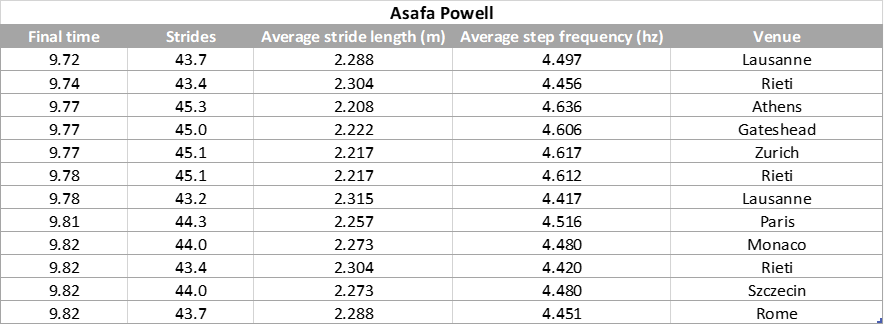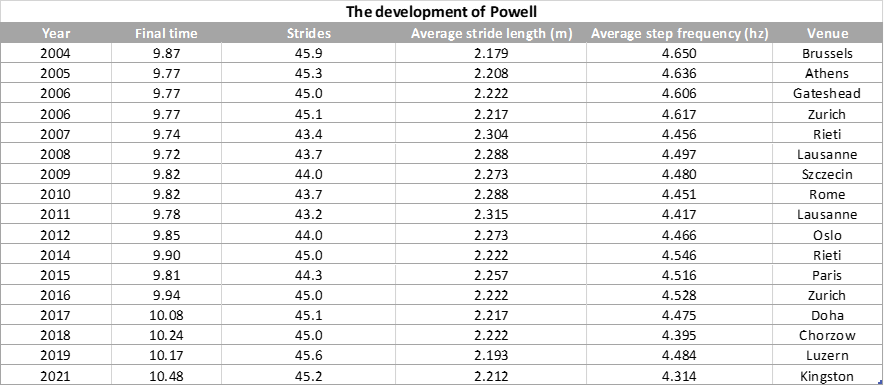Stride length and step frequency in 100m races
As a follow up to the study about stride lengths and step frequencies among sub-19.6 sprinters in the 200m I have now also done the same for sub-9.8 sprinters in 100m races. I watched the available footage in slow motion and only included the top-10 performances in which I found good enough footage to be able to count the number of strides. I have tried to make it as accurate as possible by watching the footage multiple times but there is obviously some margin of error here.











Just like in the 200m study the difficulty of finding the perfect balance between stride length and step frequency is pretty evident here as well. This is how the stride lengths and step frequencies from the personal best of each individual sprinter ranks among their top-10 performances.
Usain Bolt 9.58: Highest
step frequency and third longest stride length
Yohan Blake 9.69: Highest step frequency and fourth longest stride length
Tyson Gay 9.69: Second longest stride length and fifth highest step frequency
Asafa Powell 9.72: Fourth longest stride length and fifth highest step frequency
Justin Gatlin 9.74: Fourth highest step frequency and seventh longest stride length
Christian Coleman 9.76: Second highest step frequency and sixth longest stride length
Trayvon Bromell 9.76: Highest step frequency and seventh longest stride length
Fred Kerley 9.76: Highest step frequency and fifth longest stride length
Ferdinand Omanyala 9.77: Longest stride length and fourth highest step frequency
Nesta Carter 9.78: Highest step frequency and fourth longest stride length
Maurice Greene 9.79: Third longest stride length and fourth highest step frequency
Usain Bolt is the only
sub-9.8 sprinter who was top 3 in both categories in his personal best
performance. It is also interesting to note that neither Asafa Powell nor
Justin Gatlin was top 3 in any category during their personal best
performances.






















Here is a look at the development of the sub-9.8 sprinters. When I could not find good enough footage from their fastest performance of the year I included the fastest performance from which I could find quality footage.











Asafa Powell and Justin Gatlin probably had the most interesting development curves. Between 2004 and 2006 Powell consistently had 4.60+ step frequencies with stride lengths around ~2.20. In 2007 the stride length of Powell jumped up to 2.304 and in the process his step frequency went down to 4.456. Between 2008 and 2012 Powell continued to have stride lengths in the 2.273-2.315 range and step frequencies in the 4.417-4.497 range. Powell was in his mid-twenties when the balance between his stride length and step frequency changed and it would be very interesting to find out if it was an intentional decision from Powell and Francis to put extra focus on increasing his stride length.
During the early prime
years of Gatlin back in 2004-2005 it was his stride length that stood out the
most as he was in the 2.375-2.381 range in his best performances while his step
frequencies were in the 4.251-4.275 range. During his peak years around
2014-2016 Gatlin had a more balanced approach with stride lengths in the
2.309-2.331 range and step frequencies in the 4.387-4.446 range.
So both Powell and Gatlin
significantly changed their balance between stride length and step frequency in
the middle of their careers and reached their absolute peaks with the new
approach. It is however worth noting that they did it in different ways as
Powell made the change by significantly increasing his stride length at the
expense of some step frequency while Gatlin significantly increased his step
frequency at expense of some stride length.
The stride lengths and step
frequencies of Tyson Gay during his peak years in 2008-2010 are certainly
interesting as well. In his 9.77 from 2008 Gay had by far the longest stride
length of his career (2.278) and a significantly lower step frequency (4.493) than
what he usually had in the years before and after that. During his absolute
peak year in 2009 Gay had the two fastest and most balanced performances of his
career. In the 9.69 Gay had his second longest stride length (2.237) and his
fifth highest step frequency (4.613). In the 9.71 from the World Championships
final he had his fourth longest stride length (2.208) and his fourth longest
step frequency (4.664). In his season best of 9.78 in 2010 Gay had the highest
step frequency of his career (4.714) but a significantly shorter stride length
than normally (2.169).
The development curve of
Christian Coleman has also been noteworthy. When Coleman ran 10.06 to finish in
sixth place at the 2016 Olympic Trials he had a stride length of 2.165 and a
step frequency of 4.591. During his peak years in 2018-2019 his step frequency
had developed all the way up to the 4.806-4.820 range but as a result of that
his stride length regressed somewhat to the 2.119-2.132 range. It is however
also interesting to note that Coleman at the end of the 2023 season got his
stride length back up to the 2.155-2.165 range again but this time with step
frequencies in the 4.699-4.721 range instead of the 4.591 that he had with that
stride length back in 2016.
Yohan Blake significantly improved
on both his stride length and step frequency between his teenage years and his
peak. At age 17 in 2007 Blake had a stride length of 2.123 and a step frequency
of 4.613 which at age 22 in 2012 had developed into a 2.188 stride length and a
4.717 step frequency. The major injuries that Blake suffered at his peak seems
to have affected his ability to find an optimal balance between stride length
and step frequency. Because the times when Blake managed to produce a
performance with a high step frequency in the 4.651-4.683 range his stride
length was down in the 2.146-2.165 range and vice versa when he had longer
stride lengths his step frequencies were down.
To go from running your
first professional 100m race to having lowered the 100m world record by 0.16
seconds in just over two years is obviously an amazing development curve even
for a supreme talent who had run 20.13 in the 200m and 45.35 in the 400m
already at age 16. When comparing Usain Bolt's first 100m race of 10.03 from
2007 to his still standing world record of 9.58 from 2009 we can also see that
he improved across the board as his step frequency increased from 4.137 to
4.280 while his stride length increased from 2.410 to 2.439.
Here are the highest step frequencies per stride
length category.

Complete dominance from Bolt who has got 19 of the 20 highest step frequencies in performances with 2.40+ stride lengths. If we keep going down the list he has got 28 of the top 30 as well.

Even if we look at the 2.35+ category only Justin Gatlin and Leroy Burrell have had higher step frequencies than Bolt had in his 9.58 with a 2.439 stride length. Bolt's five performances in the top 20 also only trails Gatlin who has got six of them. It is also interesting to note that Letsile Tebogo already has got three performances in the top 20 of this stride length category.

The 2.30+ stride length category is almost completely dominated by three sprinters (Asafa Powell, Justin Gatlin and Fred Kerley) who between them have 19 of the top 20 highest step frequencies. Only Ryan Bailey managed to also make the list with his performance from the 2012 Olympic Final.


That Asafa Powell is top two in three stride length categories (1st in 2.25+ and 2.30+, 2nd in 2.20+) is a testament to just how talented he was. It is a shame that he often underperformed on the big stage but when Powell was running relaxed it was truly like watching poetry in motion.


It is interesting that Ronnie Baker appears on two lists as far apart as 2.100+ and 2.250+. His personal best performance of 9.83 from 2021 is third on the 2.250+ list while his 9.87 from 2018 is thirteenth on the 2.100+ list.



When I first counted the steps of Yuki Koike's 9.98 performance I was almost sure that I had made a mistake. But after a few double checks it became clear that he actually did take as much as 51 strides and therefore had an almost unbelievable step frequency of 5.110.
On the other side of the spectrum I have only found
ten performances with stride lengths of 2.450 or longer.

All the ten performances with stride lengths of 2.450+ are from Bolt and the longest non-Bolt stride length that I have found is 2.439 from Kemar Bailey-Cole in his 9.92 performance. Bolt has five performances with 2.488+ stride lengths. All of those came in semifinals, quarterfinals or heats where he clearly was holding back to varying degrees.
While Bolt had three sub-9.9
performances with step frequencies in the 4.054-4.072 range his most impressive
lower effort performance may actually be the 9.92 from the quarterfinals of the
2008 Olympics where he had a stride length of 2.519 and a step frequency of
4.002. Comparing Bolt's 9.92 and Koike's 9.98 it is pretty incredible that it
is possible to run 0.06 seconds faster than someone that took 1.108 more steps
per second. But that is what a difference of 0.558 metres per stride can do. To
demonstrate just how amazing the 5.110 step frequency of Koike and the 2.519
stride length of Bolt are, it is interesting to note that combining those two
results would give an unbelievable ~7.77. It is obviously impossible for anyone
to even come close to combining those results considering how differently built
those two sprinters were. Which of course is part of what enabled them to be
able to achieve such a long stride length/high step frequency. It is in fact
very difficult to even be able to have your own highest step frequency and longest
stride length in the same race as shown earlier on in this post.
If the sub-9.8 sprinters
would have been able to combine their highest step frequency with their longest
stride length (among the top-10 performances of each sprinter) these would have
been their results.

Here is the difference between their combined result and their actual personal best result.

Just like in the 200m Yohan Blake is the sprinter whose personal best is closest to his combined result. This time Usain Bolt was virtually tied with him though and both of them clearly did an amazing job when it comes to finding their perfect balance between stride length and step frequency. When I did this same exercise in the 200m study Bolt was the only sprinter that was top-3 on both the combined results list and the list of whose personal best was closest to their combined result. In this 100m study Bolt is the only one that finished top-4 on both lists. No one else was even top-6 on both lists.
It is however not a
surprise that the other three sub-9.75 sprinters Tyson Gay, Asafa Powell and
Justin Gatlin are the ones whose personal bests are the furthest away from
their combined results considering how how much they seem to have been
experimenting with the balance between stride length and step frequency during
their primes.